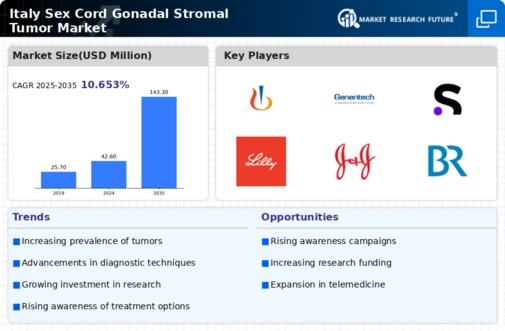The sex cord-gonadal-stromal-tumor market in Italy is characterized by a competitive landscape that is increasingly shaped by innovation and strategic partnerships. Key players such as Bristol-Myers Squibb (US), Novartis (CH), and Merck & Co (US) are actively pursuing strategies that emphasize research and development, aiming to enhance their therapeutic offerings. Bristol-Myers Squibb (US) has focused on expanding its oncology portfolio, while Novartis (CH) is leveraging its expertise in targeted therapies to address unmet medical needs. Merck & Co (US) appears to be concentrating on immunotherapy advancements, which could potentially redefine treatment paradigms in this niche market. Collectively, these strategies contribute to a dynamic competitive environment, where innovation is paramount.
In terms of business tactics, companies are increasingly localizing manufacturing and optimizing supply chains to enhance operational efficiency. The market structure is moderately fragmented, with several players vying for market share. This fragmentation allows for diverse approaches to treatment, but it also necessitates that companies differentiate themselves through unique value propositions. The influence of key players is significant, as their strategic decisions can set industry standards and drive market trends.
In October 2025, AstraZeneca (GB) announced a collaboration with a leading Italian research institution to develop novel therapies for sex cord-gonadal-stromal tumors. This partnership is strategically important as it not only enhances AstraZeneca's research capabilities but also aligns with its commitment to innovation in oncology. By leveraging local expertise, AstraZeneca (GB) is likely to accelerate the development of targeted treatments, thereby strengthening its position in the market.
In September 2025, Pfizer (US) launched a new clinical trial focused on a combination therapy for sex cord-gonadal-stromal tumors, which is expected to yield results by mid-2026. This initiative underscores Pfizer's commitment to advancing treatment options and reflects a broader trend towards personalized medicine. The outcomes of this trial could significantly impact treatment protocols and patient outcomes, positioning Pfizer (US) as a leader in this therapeutic area.
In August 2025, Roche (CH) expanded its portfolio by acquiring a biotech firm specializing in sex cord-gonadal-stromal tumor research. This acquisition is indicative of Roche's strategy to bolster its research capabilities and diversify its product offerings. By integrating innovative technologies and expertise from the acquired firm, Roche (CH) is likely to enhance its competitive edge and accelerate the development of new therapies.
As of November 2025, current trends in the market include a strong emphasis on digitalization, sustainability, and the integration of artificial intelligence in drug development. Strategic alliances are increasingly shaping the competitive landscape, allowing companies to pool resources and expertise. Looking ahead, competitive differentiation is expected to evolve, with a shift from price-based competition towards innovation, technological advancements, and supply chain reliability. This transition may redefine how companies position themselves in the market, emphasizing the importance of agility and responsiveness to emerging trends.























Leave a Comment